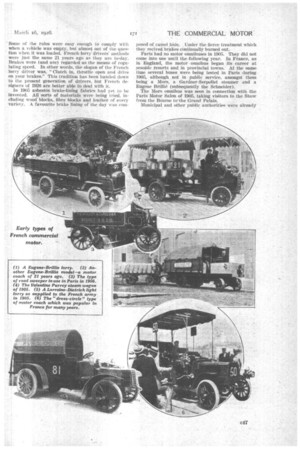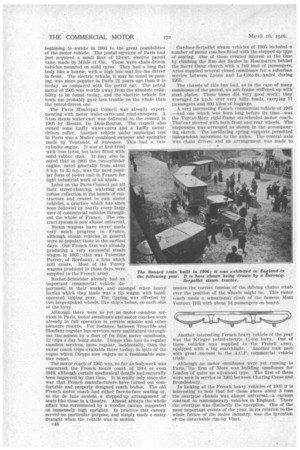FRENCH COMMERCIAL MOTORS OF 1905.
Page 52

Page 53

Page 54

If you've noticed an error in this article please click here to report it so we can fix it.
Considerable Enterprise in Nearly All Departments of the Heavy Vehicle Section of the Industry.
IT is a curious fact that, although France was the cradle of automobilism, industrial vehicle progress in that country did not, during the earlier days, altogether keep pace with the rapid development of the pleasure car. Such intense public interest was aroused by the great French road races and sporting events of the period that for the time sight seems partially to have been lost of the importance of the motor vehicle.
Not altogether, though, by any means. Twenty-one years ago a certain number of French motor manufacturing concerns: such as De Dion-Bouton, Delahaye, Panhard-Lavassor, Berliet, Peugeot, Mors, etc., already had separate heavy vehicle departments in their works and were studying the commercial car problem seriously. Manufacturers were beginning to realize that their industrial productions were designed far too much on the lines of the pleasure car, and that attention must be given to the special needs of the commercial user.
The First Important Reliability Trials.
In 1905 the first really important reliability trials devoted solely to industrial motor vehicles were held under the auspices of the Automobile Club de France. These trials lasted 12 days and comprised a round trip of about 600 kilometres for the lorries and 900 kilometres for the passenger transport vehicles, motor coaches and omnibuses taking part. The lorries made a circuit from Paris to Compeigne, Montdidier, Amiens, Dieppe, Etretat, Le Havre, Rouen and Mantes, back to Paris. The passenger vehicles made the same circuit, but by a rather longer route, taking in Lagny, Soissons, St. Quentin, Doullens, Abbeville, etc.
• FiftY-two vehicles were entered for the trials in all, an. imposing array for those days. Forty were vehicles for civil purposes and the remaining 12 military lorries. A machine which behaved quite exceptionally well in the trials was the Latil front-driver, then quite a novelty. Amongst the makes figuring in the list of starters were De Dion, Aries, Clement, Latil, Turgan, Gladiator, Gillet-Forest, Vigil& D.A.C., Krieger petrol-electric, Cottereau, Dubois Delaguere-Clayette, Cohendet et Cie, De Dietrich, Peugeot, Delahaye, Mors, Gardner-Serpollet and two foreign makes, the German Daimler and the Swiss Dufour. A comparison of the transmission systems employed at the time is interesting. Out at 12 lorries in the 3-ton and 5-ton classes five were chain driven, five had final drive by pinion and internally toothed ring on the driving wheel, and two (the Dufours) had chain and belt transmission— the last of the old brigade!
Some of the Early Difficulties.
One salient fact seems to, have emerged from these trials, namely, that iron tyres were unsuited to petroldriven lorries. Out of the 12 heavy lorries mentioned above, six were mounted on solid rubber tyres, five on iron tyres and one had solid .rubber tyres in' front and iron tyres at the rear. .
Suspension systems of the day were .still ,soinewhat.
. . .
primitive, and the success of the rubber-tyred lorries. was phenomenal. The iron-tyred vehicles by the end of their. stiff 900. kilometres' trip were suffering from cracked frames, cracked crankcases, lost parts, loose' holding-down bolts and every other trouble born of excessive vibration.
One of the special difficulties which the French heavy vehicle builder of 1905 had to deal with was the design of .efficient brakes-. Certain serious accidents with heavy vehicles, due to brake failure, had 'caused the. French authorities of the day to issue all sorts of harassing regulations with regard to brakes. Some of the rules were easy enough to comply with when a vehicle was eranty, but almost out Of the question when it was loaded. -French lorry drivers' methods were just the same 21 years ago. as they are to-day. Brakes were (and are) regarded as the means of regulating speed. In other words, the slogan of the French lorry driver was, " Clutch in, throttle open and drive on your brakes." This tradition has been handed down to the present generation of drivers, but French designers of 1926 are better able to deal with it.
In 1905 asbestos brake-lining fabrics had yet to he invented. All sorts of materials were being tried, including wood blocks, fibre blocks and leather of every variety. A favourite brake lining of the day was coin posed of camel hide. .Under the tierce treatment which they recived,brakes continually burned out.
Paris' had no motor omnibuses in 1905. They did not come into use until the following year. In France, as in England, the motor omnibus began its career at seaside resorts and in provincial towns. At the same time several buses were being tested in Paris during 3905, although not in public service, amongst them being a Mors, a Gardner-Serpollet steamer and a Eugene Brilhid (subsequently the Schneider).
The Mors omnibus was seen in _connection with the
Paris Motor Salon of 1905.. taking visitors to -the Show from the Bourse to'the Grand Palais.
Municipal and other public authorities were already
beginning to awake in 1905 to the great possibilities of the motor vehicle. The postal services of Paris had just acquired a small fleet of 12-cwt. electric parcel vans, made by Milde et Cie. These were chain-driven vehicles mounted on solid tyres. They had a long flat body like a hearse, with .a high box seat for the driver in front. The electric vehiclei it may be noted in passing, was more popular in Paris 21 years ago than it is to-day, as compared with the petrol car. The petrol motor of 1905 was worlds away from the absolute reliability to be found to-day, and the electric vehicle for town use probably gave less trouble on the whole than the petrol-driven one.
The Paris Municipal Council was already experimenting with motor water-carts and road-sweepers. A 5-ton steam water-cart was delivered to the council in 1905 by Messrs. De Dion-Bouton. The council also owned some Laffly water-carts and a Laity motordriven roller. Another vehicle under municipal test in Paris was a Muller combined sweeper and sprinkler made by Tourands, of Saresnes. This had a twocylinder engine. It was at first tried with iron tyres, but later fitted with solid rubber ones. It may also be noted that in 1905 the two-cylindet engine, rated generally from about 8 h.p. to 12 h.p., was the most popular form of power unit in France for light industrial work of all kinds.
Later on the Paris Connell put all their street-cleaning, watering and refuse collection in the hands of contractors and ceased to own motor vehicles, a practice which has since been followed by nearly every large user of commercial vehicles throughout the whole of France. The contract system is now almost universal.
Steam wagons have nevermade very much progress in France, although steam vehicles in general were so popular there in the earliest days. One French firm was already producing a very successful steam Wagon in 1905 ; -this was Valentine Purrey, of Bordeaux, a firm which still exists. Most of the Purrey wagons produced in those days were supplied to the French army.
Rochet-Schneider already had an important commercial vehicle department in their works, and amongst other heavy lorries which they made was a tip wagon with handoperated tipping gear. The tipping was effected by two large-spoked wheels, like ship's helms, on each side of the lorry.
Although there were as yet, no motor omnibus services in Paris, motor omnibuses and motor coaches were already in full operation in certain seaside and other pleasure resorts. For instance, between Trouville and Honfleur regular bus services were maintained throughout the season by a fleet of De Dion motor omnibuses, 12 trips a day being made. Dieppe also had its regular omnibus services, more regular, incidentally, than the motor coach trips available there to-day, in spite of the vogue which Dieppe now enjoys as a fashionable summer resort.
The motor coach of 1905 was, so far as bodywork was concerned; the French motor coach of 1914 or even 1919, although certain mechanical details had naturally been improved by that time. It is really only since the war that French manufacturers have turned out comfortable and properly designed coach bodies. The old French motor coach had either face-to-face seating or, in the de luxe models, a stepped-up arrangement of seats like those in a theatre. Almost always the whole affair was surmounted by a wooden canopy supported on immensely high uprights. In practice this canopy served no particular purpose, and simply made a nasty draught when the vehicle was in motion.
c48 Gardner-Serpollet steam vehicles of 1905 included a number of motor coaches fitted with the stepped-up type of seating. One of these created interest at the time by climbing the Rue des Saules in Montmartre behind the Sacre Coeur church with a full load Of passengers. Aries supplied several closed omnibuses for a suburban service between Lyons and La-Cote-St-Andre during 1905.
The chassis of this bus had, as in the case of many omnibuses of the period, an ash frame stiffened up with steel plates. These buses did very good work ; they averaged 24 k.p.h. over very hilly roads, carrying 17 passengers and 800 kilos of baggage.
. A very interesting French commercial vehicle of 1905 —and one which was born long before its time—was the Turcat-IVIery rigid-frame six-wheeled motor coach. ThiS" car steered with both front and rear wheels. The suspension was arranged as shown in the accompanying sketch. The oscillating spring supports permitted independent movement-to the axles. The central axle was chain driven, and an arrangement was made to
Another interesting French heavy vehicle of the year was the Krieger petrol-electric 4-ton lorry. One of these vehicles was supplied to the French rmy, ecfnipped with a big searchlight. Another took part with great success in the A.C.F. commercial vehicle trials.
Although no motor omnibuses were yet running in Paris, —the firm of Mors was building omnibuses for London of quite an advanced type. The first of these were seen in service in 1905 between Charing Cross and , Brondesbury.
In looking at the French heavy vehicles of 1905 it is interesting to note that for those above about 3 tons the overtype chassis was almost universal—a curious contrast to contemporary vehicles in England. There the overtype was distinctly the exception. One of the most important events of the year, in its relation to the whole future of the motor industry, was the invention of the detachable rim by Vinet.


























































